Rumble in the Graveyard
Rumble in the Graveyard
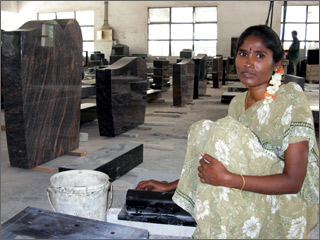
tombstone factory in Pondicherry, developed its gravestone industry, now coveted
by China (Photo: © Margot Cohen)
CHENNAI: The palette of Indian granite summons an ethereal world beyond: Blue Galaxy, Paradiso, Indian Aurora and Himalayan Black are just a few of the hues on offer from this mineral-rich nation.
Such colors have long been India's biggest selling point in the global gravestone business, or as insiders call it, the "monument and memorial industry." As bereaved Western consumers opted for diverse tombstones during the 1980s and 1990s, Indian manufacturers expected to earn an eternal place of pride in the graveyards of the US and Europe.
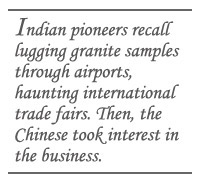
But Chinese competition has shattered these serene projections. Over the past six years, manufacturers in China have managed to import rough blocks of the coveted colored granite from India, craft the tombstones at home, ship them all over the world and still sell them at prices 10 to 30 percent below those of markers made in India. This increasingly successful Chinese strategy has left the Indians scrambling to boost productivity, hone customer ties and reclaim market share.
For Indian pioneers who recall relentless hours spent lugging 30 kilos of granite samples through airports and haunting international trade fairs, the competition is troubling. "The market was ready and built by the Indians," says R. Veeramani, chairman of the Chennai-based Gem Group, one of India's leading exporters of monuments and granite blocks. "The Chinese walked into it."
The move underscores China's uncanny ability to diversify its exports and target new markets. That talent is also reflected in Sino-Indian trade. Amidst the cheerful news that bilateral trade is increasing by nearly 50 percent this year after reaching $25 billion in 2006, India is growing uneasy over its swelling trade deficit with China – which hit $4.1 billion last year and continues to rise. In worldwide markets, India is still straining to become a more serious competitor to China in textiles, apparel, electronics and machinery.
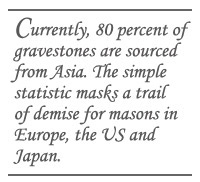
China's graveyard gambit is just the latest jolt in a long global ride for an industry bound to benefit from an aging population. Currently, 80 percent of gravestones are sourced from Asia. That simple statistic masks a long trail of demise, as thousands of traditional masons and entrepreneurs in Europe, the US and Japan bowed to India and China. Like the arbitrage underway in the international seafaring community – where waves of British, Russian, Polish, Indian, Filipino, Chinese and Vietnamese seamen have come and gone at the whim of market forces – the search for the bargain tombstone is likely to persist.
A British sailor first slipped the idea to an Indian mining friend in Andhra Pradesh that he might start exporting monuments to England. The year was 1942, the height of World War II with its grim schedule of daily burials. At first, the new company Evershine produced the gravestones in traditional fashion, polishing and chiseling by hand. Eventually, in the 1970s, the company began importing some basic machinery from Europe and the business spread to the neighboring states of Karnataka and Tamil Nadu.
Today, among India's 100 or so gravestone factories, the import of sophisticated machinery from Europe and Japan is seen as key to trumping their Chinese rivals on quality.
But some Chinese industrialists scoff at the notion that imported machinery guarantees superior workmanship. They make their own equipment, thereby helping to undercut Indian wholesale prices. "The machinery from Europe is not working efficiently," says Antony Ma, general director of Tianjin Zhongjian Wanli Stone Co., Ltd., which sent 300 containers filled with tombstones in 2006 to varied ports in the US, Europe and Japan.
Japan was the first market that China swiped from India during the 1990s, but only after India had benefited from the closure of many traditional Japanese firms during an economic recession. At first, Chinese manufacturers were emboldened by the fact that the elegant Japanese models relied on black and gray. These were colors that China could quarry within its own borders. Soon, Japanese entrepreneurs pitched in to develop the industry by setting up joint ventures in China.
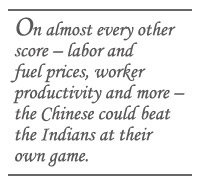
But so many firms jumped into the fray that prices dropped and profits shrank. Even though China commanded 97 percent of the Japanese market by 1999, the Western graveyards looked more enticing. After some calculations, the Chinese figured out that raw materials would comprise only 20 to 25 percent of the finished product's cost. On almost every other score – labor and fuel prices, worker productivity, infrastructure development and credit availability – the Chinese could beat the Indians at their own game. Moreover, they knew they could achieve a faster delivery time, due to geography and shipping schedules.
To compete, the Indian managers leaned on their sculptors. Long praised for carrying on India's tradition of intricate temple carving, they suddenly felt a blast of industrial time-management. "Our managers told me, there is competition with China, so you have to work fast," recounts D. Asalan, a sculptor employed at Gem Granite in Chennai. "But quality is also important."
Asalan recently put the finishing touches on a huge grave-marker resembling a pagoda, fashioned from India's Imperial Red granite. The firm plans to ship it to a Chinese family in California – one order that didn't fall into Tianjin's lap.
Of course, there are limits to this global supply chain. Monuments from India or China are typically shipped without the name of the departed carved into the stone. Manufacturers fear that employees might misspell an unfamiliar foreign name, swiftly ruining an item that sells for thousands of dollars or euros. So the delicate work is completed after delivery.
Market divisions remain unclear. Indian officials say that the European tombstone import market is about 65 percent from India and 35 percent from China – as French and German masons struggle to stay in business. For North America, the estimated divide is 60 percent from India and 40 percent from China – while domestic tombstones are still fashioned in Georgia and Vermont. But the Chinese argue that they are emerging on top in the US, while the Japanese market remains firmly in their hands.
Businessmen like Ma are not crowing just yet. Chinese companies are concerned about rising taxes and greater investments to comply with official anti-pollution campaigns. Such factors could shave the price differential.
Meanwhile, the Indian contingent expresses optimism. "They cannot crush us," declares K. Subba Reddy, chairman of the Chennai-based Pallava Group, another top exporter of monuments and granite blocks, adding that India can still select the choice blocks of granite in its own quarries, thereby determining superior quality.
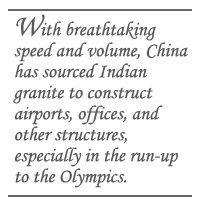
Ironically, some of India's major gravestone manufacturers have reason to thank the Chinese. Since they also run their own quarries, they know that China essentially rescued the Indian granite industry from the doldrums it faced just seven years ago. With breathtaking speed and volume, China has sourced Indian granite to construct airports, apartments, offices, and other structures, especially in the run-up to the Olympics. Today, China buys 45 percent of all Indian granite.
Overall, India still struggles to understand China's dual role as competitor and customer. Like the speckled veneer of Himalayan Green granite, global trade can't be reduced to a single color.
Margot Cohen is a journalist based in Bangalore.
Comments
Indian Government should ban the export of blocks to China or should levy a duty. The Importers from China are importing blocks and processing them with huge machinery. It has two adverse effect
1. Indian Manufacturer have to buy blocks at the high price
2. India losing foreign currency and Job market.
However, we met several people from different types of countries who prefer to buy from India instead of China. They know that these products are from India, and they can get these stones at good prices from India.